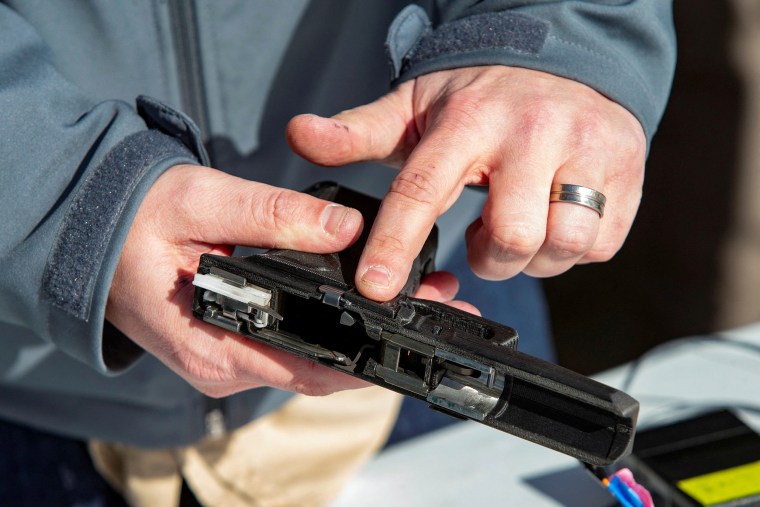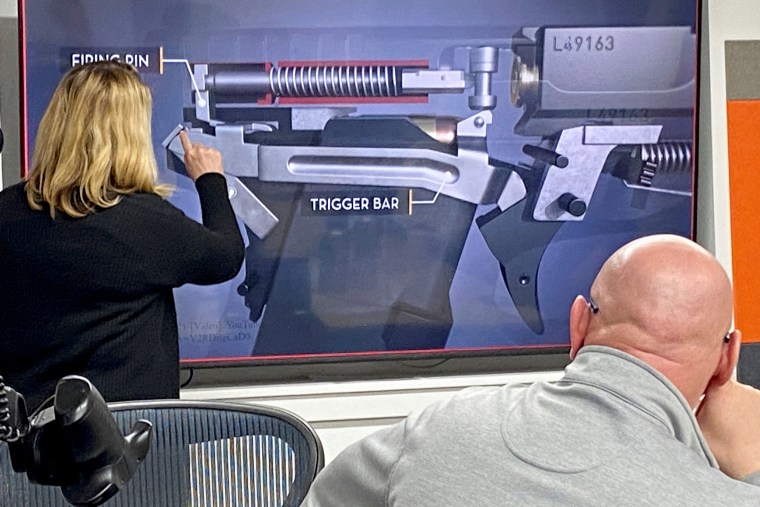Product: Smart Guns : Wanting: Smart Users
 |
"In times of stress, somebody who is authorized is going to pick up the firearm but they have to do that [extra] step.""Maybe it makes them pause and go 'Hey, do I really want to be doing this right now'?""[User authentication steps are a physical buffer against accidents, suicides and crimes—and a psychological barrier.]"Ginger Chandler, co-founder, smart gun maker LodeStar Works"The whole smart gun argument ignores the most common way guns are used to kill in the US—suicide by the person who bought the gun."Daniel Webster, director, Johns Hopkins Center for Gun Policy and Research"I don't have a crystal ball to know whether it's going to be good on balance, bad on balance or ultimately like other smart guns in the past—kind of a dud."Adam Skaggs, chief counsel and policy director, gun control advocacy group Giffords
 |
| Colorado-based Biofire is also developing a smart gun with a fingerprint reader, which was designed by 19-year-old Kai Kloepfer. Kloepfer spent four years designing a handgun with a fingerprint reader built into the grip and won the Smart Tech Challenges Foundation in 2014 for the innovation |
Hope
and skepticism, but it's on its way into the American firearms market,
and likely before long the innovative technology will be established
elsewhere around the globe. Not, however, taking the place of arms
illegally used or valued by drug cartel and smuggling gangs, not to
mention militias in areas of the world where shooting is designed for
and meant to kill.
There
is certainly a promise, an allure of a personalized smart guns designed
to be fired exclusively by verified users and their circulation in the
United States follows two decades of uncertainty about reliability
amidst concerns a new wave of government regulation will be ushered in
to meet a new challenge. Safety and security is the key selling point in
a nation where gun ownership and gun deaths are legendary.
A
9mm smart handgun was unveiled for shareholders and investors by
LodeStar Works in Boise, Idaho this month. Law enforcement agents,
according to Kansas-based SmartGunz LLC, are beta testing its own
product, smaller and simpler in design. Both companies aspire to have a
finished product commercially available to consumers this year.
The
inspiration for LodeStar was hearing about too many stories of children
shot while playing with an unsecured firearm, according to the
company's co-founder, Gareth Glaser. Such tragedies could be stopped
through the use of technology that must authenticate a user's identity
to enable use of the gun; otherwise it is disabled when an unauthorized
user attempts to shoot.
Test-firing
of the LodeStar gun is new. A third-generation prototype was fired by a
range officer without issue. The cost of such a weapon would be US$895
retail. Large-scale manufacturing would come with its own challenges,
but following years of trial and error the technology is considered
sufficiently advanced, the microelectronics well-protected in the gun
interior.
"We finally feel like we're at the point where ... let's go public. We're there",
said Glaser. Either fingerprint unlocking or radio frequency
identification technology enabling the gun to fire only when a chip in
the gun communicates with another chip worn by the user in a ring or
bracelet, exemplified most early smart gun prototypes.
Both
a fingerprint reader and a near-field communication chip activated by a
phone app, plus a PIN pad has been integrated by LodeStar in its new
product. More than one user can be authorized for the gun's use, where
the fingerprint reader unlocks the gun in microseconds. It may not,
however work, when wet or in other adverse conditions, so the PIN pad is
there as a backup to enable the gun as swiftly as users open the app on
their phones.
SmartGunz'
weapons are secured by radio frequency identification in a model
developed to sell at US$1,785 for law enforcement, and US$2,195 for
civilian use according to Kansas Democratic State Senator Tom Holland
who co-founded the company in 2020. Biofire based in Colorado is
developing a smart gun with a fingerprint reader.
"If
I had a nickel for every time in my career I heard somebody say they're
about to bring us a so-called smart gun on the market, I'd probably be
retired now", Lawrence Keane, senior vice president of
the National Shooting Sports Foundation, the firearms industry trade
association said.
"The other side tipped their hand because they used smart guns to ban everything that's not a smart gun", executive director Scott Bach of the Association of New Jersey Rifle & Pistol Clubs said. "It woke gun owners up." In
reference to a 2019 New Jersey law that all gun shops in the state
offer smart guns once they become available, replacing a 2002 law that
would ban the sale of any handgun other than smart guns.
In
1999 Smith & Wesson pledged to promote smart gun development in an
agreement with the U.S. government, leading the National Rifle
Association to sponsor a boycott leading to a drop in revenue, in
response.
German
company Armatix in 2014 put a smart .22 calibre pistol on the market
but when hackers found a way to remotely jam the gun's radio signals and
with the use of magnets, fire the gun when it should have been locked,
it was pulled from stores.
 |

Labels: Firearms Markets, Smart Guns, Technology, United States

<< Home